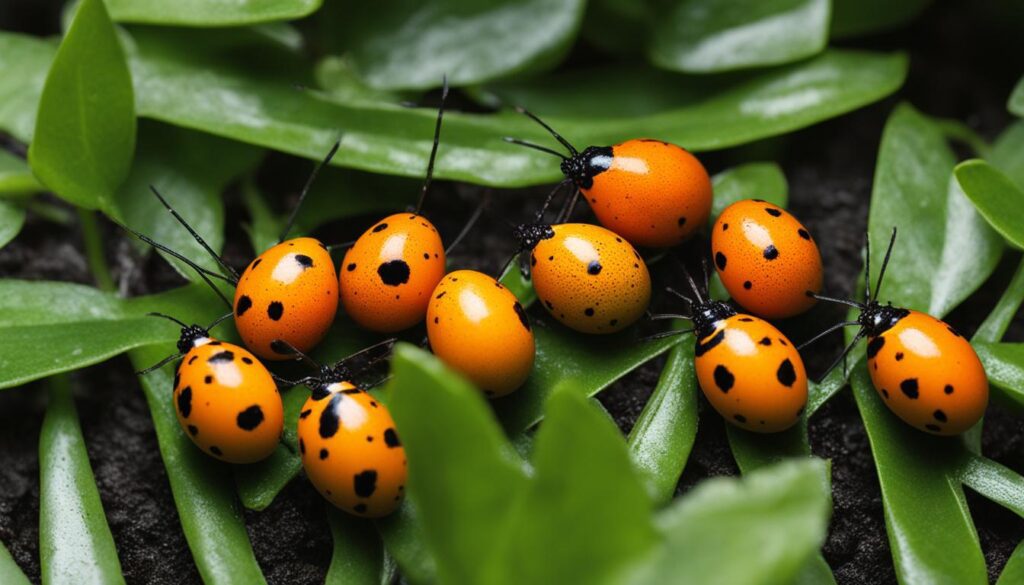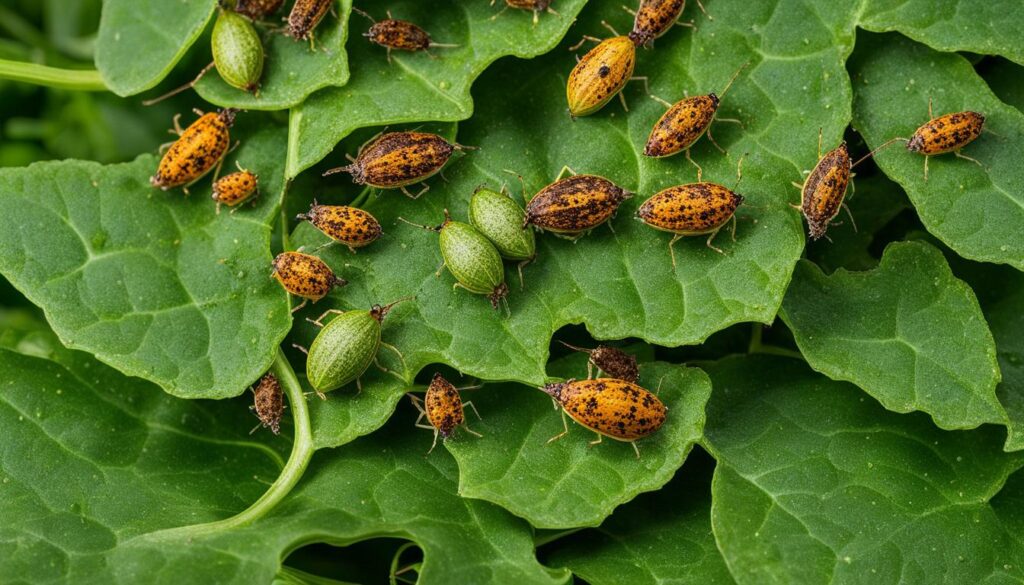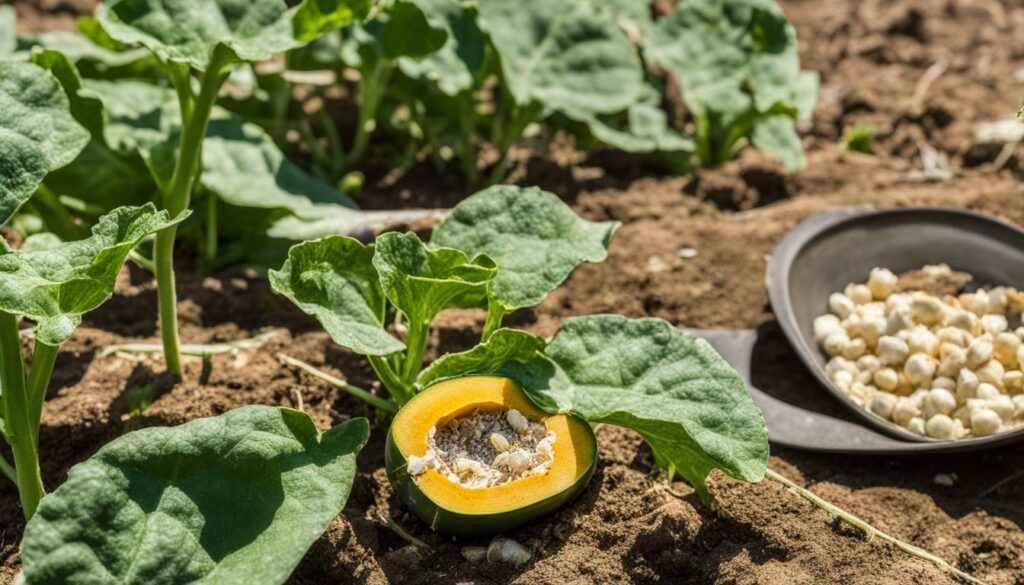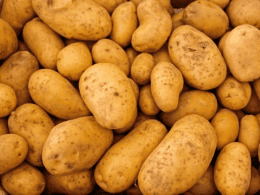Welcome to our article on spotting squash bug eggs! If you’re a gardener, it’s crucial to be able to identify these eggs, as they are the starting point for a potential squash bug infestation. By learning about the appearance of squash bug eggs, you can take proactive measures to protect your plants and prevent damage.
Squash bug eggs are small and oval-shaped, measuring about 1/16 inch in length. They have a yellowish to bronze color, making them easily distinguishable from other garden eggs. Female squash bugs usually lay these eggs in small clusters, typically around 20 eggs, on the undersides of leaves, especially between the veins. You may also find the eggs on the stems of your plants.
It takes approximately 10 days for the squash bug eggs to hatch, and once they do, the nymphs go through five stages of development before reaching adulthood. Knowing what squash bug eggs look like and where to find them is the first step in effectively managing and controlling these pests.
Key Takeaways:
- Squash bug eggs are oval-shaped and yellowish to bronze in color.
- They are usually laid in small clusters on the undersides of leaves and stems.
- Eggs take about 10 days to hatch, and the nymphs undergo five stages of development.
- Identifying squash bug eggs is essential for preventing infestations and protecting your plants.
- Regular inspection of your squash and pumpkin plants can help you spot squash bug eggs early.
Identifying Squash Bugs and their Nymphs
When it comes to dealing with squash bugs, it’s important to know how to identify both the adults and the nymphs. Adult squash bugs are large insects, measuring about 5/8 inch long. They have a flattened body shape and are typically dark gray to dark brown in color. One of the key characteristics of adult squash bugs is the alternating orange and brown stripes on their abdomens, which make them stand out.
As for the nymphs, they go through several stages of development before reaching adulthood. When they first hatch from the eggs, the nymphs have a light green abdomen and black heads and legs. As they mature, their color changes, turning light gray and then brownish-gray with black legs and antennae. Identifying the nymphs is essential for early detection and control of squash bug infestations.
“Adult squash bugs are usually dark gray to dark brown and have alternating orange and brown stripes on their abdomens.”
To help you visually identify squash bugs and their nymphs, refer to the image below:
Physical Characteristics of Squash Bugs:
- Adult squash bugs: large, flattened body, 5/8 inch long, dark gray to dark brown, alternating orange and brown stripes on abdomen.
- Squash bug nymphs: undergo color changes, light green abdomen and black heads and legs when newly hatched, turn light gray and then brownish-gray with black legs and antennae as they mature.
By being able to identify squash bugs and their nymphs, you can take appropriate measures to control their populations and protect your squash and pumpkin plants.
Lifecycle and Behavior of Squash Bugs
Squash bugs have a fascinating lifecycle and exhibit specific behavioral patterns. Understanding these aspects can help you effectively manage and control their presence in your garden.
Overwintering: Squash bugs have the ability to survive the winter as adults. They seek sheltered places such as under plant debris, around buildings, or under rocks. This allows them to remain protected from harsh weather conditions and emerge in the spring ready to feed and mate.
Reproductive Behavior: Female squash bugs lay their eggs in clusters on the undersides of leaves, typically appearing in gardens from early June through mid-summer. The eggs are usually found in small clusters of about 20, and they take approximately 10 days to hatch. The nymphs go through several stages before reaching adulthood, undergoing color changes and physical transformations along the way.
Lifecycle: Squash bugs follow a single-generation lifecycle each year, but in some summers, there may be a partial second generation. This means that the population of squash bugs can increase rapidly if not managed effectively. Monitoring the presence of eggs, nymphs, and adults throughout the growing season is essential to prevent infestations and minimize damage to your plants.
By understanding the lifecycle and behavior of squash bugs, you can implement preventive measures to protect your plants. Regularly checking for eggs, removing them, and monitoring the presence of nymphs and adults can significantly reduce their impact on your garden. Additionally, practicing good garden hygiene by cleaning up plant debris in the fall can help eliminate potential overwintering sites. These proactive measures, along with early detection and intervention, will ensure the health and vitality of your squash and pumpkin plants.
Damage Caused by Squash Bugs and Prevention Measures
Squash bugs can wreak havoc on your squash and pumpkin plants, causing significant damage that can hinder their growth and productivity. It’s important to understand the potential harm caused by these pests and take appropriate preventive measures to protect your plants. Here’s what you need to know:
Damage caused by squash bugs:
- Squash bugs suck the sap from the leaves, leading to the development of yellow spots that eventually turn brown.
- Their feeding can disrupt the flow of water and nutrients, causing wilting and stunted growth.
- In severe cases, squash bugs can also lead to fruit rot, impacting the quality and yield of your harvest.
To safeguard your plants from squash bugs, it’s crucial to implement preventative strategies and early detection methods:
Protecting plants from squash bugs:
- Maintain healthy plants through proper fertilization and watering. Vigorous, robust plants are better equipped to withstand pest attacks.
- Regularly inspect the undersides of leaves for squash bug eggs and nymphs. Remove and destroy any clusters of eggs or immature bugs you find.
- Create physical barriers around your plants by placing boards or pieces of newspaper around the base. This can deter adult squash bugs from reaching the leaves to lay eggs.
“Early detection of squash bug nymphs is crucial, as they are difficult to kill. Removal of squash bugs and their eggs, using physical barriers like boards or pieces of newspaper, and cleaning up plant debris in the fall can help reduce infestations.” – Gardening Expert
If you’re dealing with a severe squash bug infestation, you may need to resort to insecticides. However, it’s important to choose an appropriate product and follow the instructions carefully to minimize harm to beneficial insects and pollinators. Insecticides are most effective when targeted at immature nymphs, as they are more vulnerable to treatment.
By taking proactive measures and staying vigilant, you can protect your squash and pumpkin plants from the damage caused by squash bugs. By maintaining healthy plants, removing eggs and bugs, and using insecticides only when necessary, you can significantly reduce the risks of infestations and ensure a bountiful harvest.
Conclusion
Squash bugs can be a common and troublesome pest for your squash and pumpkin plants, causing wilting, yellow spots, and even fruit rot. However, by understanding how to identify squash bug eggs and their lifecycle and behavior, you can take control of the situation and manage infestations effectively.
One of the key steps in managing squash bugs is to maintain healthy plants. Proper fertilization and watering practices help keep your plants strong and resilient, making them less attractive to these pests. Regularly inspecting your plants for signs of squash bug nymphs and removing them promptly can also prevent infestations from taking hold.
Physical removal of squash bugs and their eggs is another effective method to manage infestations. You can use physical barriers such as boards or pieces of newspaper to trap and dispose of the bugs. Additionally, cleaning up plant debris in the fall can eliminate potential overwintering sites for squash bugs.
In severe cases, the use of insecticides may be necessary. Targeting the vulnerable immature nymphs with appropriate insecticides can help control the population. However, always follow the instructions on the label and use insecticides responsibly.
– Can Mosquito Repellent Plants also Help Keep Squash Bugs Away?
Yes, mosquito repellent plants like citronella, lavender, and marigolds can also help keep squash bugs away in your backyard. These plants emit natural odors that repel insects, making them a great addition to your garden to help protect your squash plants.
FAQ
How do squash bug eggs look like?
Squash bug eggs are oval-shaped, measuring 1/16 inch long. They are yellowish to bronze in color.
Where do female squash bugs lay their eggs?
Female squash bugs lay small clusters of eggs, usually about 20, on the undersides of leaves, especially between the veins. The eggs can also be found on stems.
How long does it take for squash bug eggs to hatch?
It takes about 10 days for the squash bug eggs to hatch.
What do squash bug nymphs look like?
Squash bug nymphs initially have a light green abdomen and black heads and legs. As they mature, they turn light gray and then brownish-gray, with black legs and antennae.
How do squash bugs overwinter?
Squash bugs can live through the winter as adults in sheltered places, such as under plant debris, around buildings, or under rocks.
When do squash bugs appear in gardens?
Squash bugs appear in gardens from early June through mid-summer
What plants do squash bugs primarily attack?
Squash bugs primarily attack squash and pumpkins.
How do squash bugs damage plants?
Squash bugs suck the sap from the leaves, causing yellow spots that eventually turn brown. Their feeding can affect the flow of water and nutrients, leading to wilting.
How can I protect my plants from squash bugs?
To protect plants from squash bugs, it is important to maintain healthy, sturdy plants through proper fertilization and watering. Early detection of squash bug nymphs is crucial. Removal of squash bugs and their eggs, using physical barriers like boards or pieces of newspaper, and cleaning up plant debris in the fall can help reduce infestations. Insecticides may be necessary in severe cases, targeting immature nymphs that are more vulnerable to treatment.











